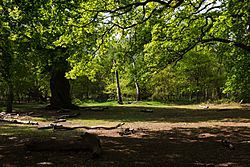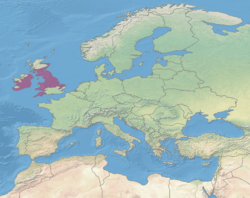Celtic broadleaf forests facts for kids
Quick facts for kids Celtic broadleaf forests |
|
|---|---|

|
|

Location of the Celtic broadleaf forests
|
|
| Ecology | |
| Realm | Palearctic |
| Biome | temperate broadleaf and mixed forests |
| Borders | Caledonian forest, English Lowlands beech forests and North Atlantic moist mixed forests |
| Geography | |
| Area | 209,000 km2 (81,000 sq mi) |
| Countries | Republic of Ireland and United Kingdom |
| Conservation | |
| Conservation status | critical/endangered |
The Celtic broadleaf forests are a special type of forest area, called an ecoregion, that covers most of Great Britain and Ireland. Imagine a huge natural space where certain plants and animals live together! These forests are found across these islands.
Contents
Where are the Celtic Broadleaf Forests?
These amazing forests cover most of the islands of Great Britain and Ireland. This includes the Republic of Ireland and parts of the United Kingdom. You can find them in England, Scotland, Wales, and Northern Ireland.
Not all parts of these islands are covered by these forests. For example, some areas in western Ireland and Scotland are home to the North Atlantic moist mixed forests. The Scottish Highlands have a different type of forest called the Caledonian forest. Also, southeastern England has its own unique English Lowlands beech forests.
What is the Climate Like?
The climate in these forests is called oceanic. This means it gets a lot of rain and has many rainy days. There's also a lot of moisture in the air, and not much sunshine. Because of this, the air often feels damp. Extreme temperatures, like super hot or super cold days, are rare here.
What Plants Grow Here?
The Celtic broadleaf forests are home to many different kinds of plants. The main trees you'll see are:
- Forests with oak trees, especially in lower areas.
- Mixed oak forests, mostly with two types: the English oak and the sessile oak.
- Forests that mix oak and ash trees.
You might also find smaller areas with:
- Birch forests, especially in western and mountain areas.
- Forests in wet, marshy places like fens and swamps.
- Special wet areas called mires in northern England and southern Scotland.
Besides the two native oak species, other common broadleaf trees include the common ash, silver birch, European aspen, and the common elm.
What Animals Live Here?
Many cool animals call the Celtic broadleaf forests home. Some of them are:
- European otter
- European badger
- Red deer
- Roe deer
- Stoat
- Weasel
- Greater horseshoe bat
- Lesser horseshoe bat
- European hedgehog
- Red fox
Sadly, many other animals that once lived here are now gone from these areas. This happened because of things like cutting down too many trees, hunting, and using too many natural resources. Animals like the grey wolf, brown bear, wild boar, Eurasian lynx, and European beaver used to be common across these islands.
Why are These Forests Important?
Over the last few thousand years, about 90% of the original Celtic forest has disappeared. This was mainly due to farming, using wood for fires, and general tree clearing. What's left of these forests is often broken up into smaller pieces.
Today, these forests are in a critical state. Most of the land that was once thick forest is now rolling hills used for farming, which is what many people think of when they picture England. Protecting these remaining forest areas is very important for the plants and animals that depend on them.
A Look Back in Time: Prehistory
These forests are quite young in terms of Earth's history. That's because they were covered by thick ice during the last Ice Age!
People started living here shortly after the ice melted, about 9,000 to 8,000 years ago. These early people, called Mesolithic peoples, lived across what is now England, Wales, Ireland, and eastern Scotland.
We know from old discoveries that towns like York existed for a thousand years before the Romans arrived. The written history of this area really begins when the Romans built big towns here in the first century CE. Later, from about the ninth century CE, Vikings also settled widely along the coasts of western Scotland, Wales, and eastern Ireland.
Images for kids



